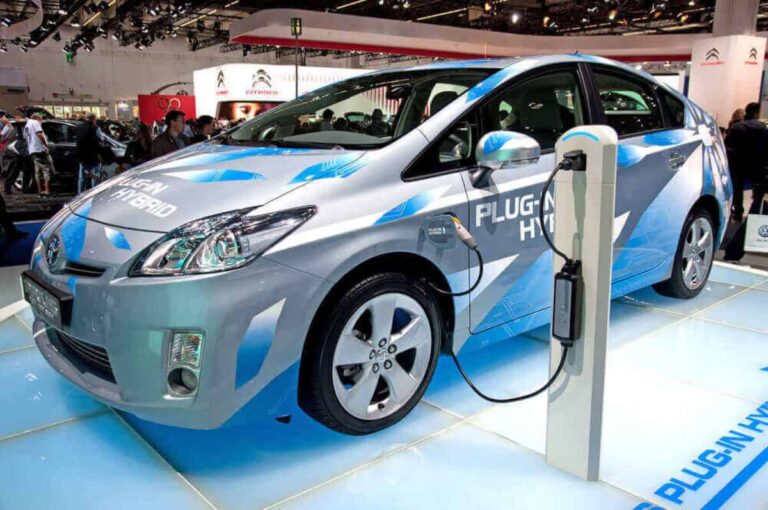Electric vehicles are not new and Tesla is just one out of many brands that have pursued the electric-mobility dream.
An electric vehicle or EV is any vehicle that uses electric power for propulsion. That power could come from a wide range of sources, as long as it is electric.
The use of electricity makes cars easier to drive, more environmentally friendly, less noisy, and overall more comfortable for the entire family.
This post takes a closer look at EVs, what they mean for humanity, and what the future holds.
The first electric vehicles
Electric vehicles date back to the 19th century when the internal-combustion engine had not achieved the high efficiency we know today. The earliest recorded electric motor is from the Hungarian priest Anyos Jedlik in 1827, while the first use of electricity in powering a car came in 1835.
Locomotives also came into the spotlight by 1838. The 5-meter Le Téléphone boat invented by the French Gustave Trouvé reached a 5.6 mph top speed in 1818, and by the early 1900s, mass-produced electric vehicles were a reality.
They were limited in speed and range, however, but electricity was a much better alternative back then than was the steam engine, which often required over a half hour to warm up on cold days.
Lead-acid and Humming Birds
The major reason for the electric vehicle’s success can be traced back to the invention of the lead-acid battery by Gaston Planté, a French scientist, in 1859. And as the technology developed, it led to electrically powered cars being very practical because you could charge them before use.
London, for instance, got a fleet of battery-powered taxis in 1897 and they were fondly called “Hummingbirds” for their quiet, humming noise. Electric cars got so successful that by 1900, 38% of cars in the United States were powered by electricity, 40% by steam, and only 22% had an internal combustion engine (gasoline-powered).
Yet, they were often referred to as women’s cars, because women benefited most from their ease of use. Their limited range and the limited charging station availability also meant they were most useful as city cars.
Model T and the fall of EVs
The Internal Combustion Engine was equally experiencing development all this while. And as roads expanded outside cities and turned into highways, ICEs could travel faster and farther, while EVs were often limited to a 20-mph top speed and a 40-mile range.
This development started to tilt the scale in favor of the ICE. So, when Henry Ford introduced his mass production system and brought the Model-T into existence, things started to change.
Internal combustion-engine vehicles were getting cheaper while electric-vehicle development stagnated, and by 1913, a gasoline car cost about half the price of an electric car. That’s how EVs slowly disappeared from the mass market, thanks mostly to Ford.
A new beginning
New research into electric-car technology began again around the 1960s and 70s. Many companies came up with different bright ideas in this period, but none was a commercial success.
The energy crisis of the 70s and 80s also helped to create more pressure on finding alternative energy and mobility solutions. These efforts shifted into fuel efficiency and lower engine emissions by the 1990s. EVs were still made here and there, but none was yet a major commercial success.
Lithium-Ion and The Tesla
Tesla Motors began the development of the Tesla Roadster in 2004 and delivered the first units in 2008. They ran on Lithium-ion batteries, a technology invented in the 1980s and used primarily in electronic gadgets.
This Tesla roadster could also travel up to 200 miles (320 km) per charge. It featured a 53 kWh battery pack and a 185-kW rated 3-phase AC motor that produced 248 horsepower. This helped it accelerate from 0 to 60 in 2.9 seconds, although it got limited to 5.7 seconds, and tops out at 130 mph.
People loved the Roadster. It looked cool, modern, and trendy. So, Tesla sold a ton of them, reaching 2,450 units in 2012 and the rest is history.
The problem with electric cars
The single biggest problem with electric cars is energy portability. That is, an energy generation or storage system that is compact enough to fit nearly everywhere but still produces enough power for hundreds, if not thousands, of miles.
Two major applications here are the hydrogen cell generator and battery storage. Both technologies have their advantages and disadvantages over one another.
Fuel cells that run on hydrogen and produce enough power to move cars have been demonstrated, but they are not yet practical. Their major drawback is the high cost of the fuel-cell generator, which requires rare and expensive materials to produce. This makes fuel-cell’s future appear bleak when compared to battery storage. However, hydrogen trains, and other specialized use cases, could prove more practical.
For batteries, the rebirth of rechargeable electric vehicles came with improvements in storage technology. But notwithstanding the numerous improvements and development of the Lithium-ion battery, there are still a few issues.
Battery swapping, for instance, is still not possible with most electric cars, given their size. Lithium-ion batteries also tend to overheat, especially when damaged in a crash. And this can lead to fires.
Thirdly, while about 90% of stored energy from a battery is converted to mechanical energy, this energy still boils down to about 60% of the total grid energy used in recharging the battery. So, there is still room for improvement.
Common electric vehicle terms
You will often find certain EV-related terms thrown around electric cars and this might be confusing for some. So, here are the main ones and what they mean.
- HEV – Hybrid Electric Vehicle. This vehicle uses liquid fuel to generate the energy that charges its battery and powers the wheels. You cannot plug it in or charge it externally.
- PEV – Plug-in Electric Vehicle. This term refers to any vehicle that you can plug in for recharging. It does not matter if it still uses liquid fuel or not.
- PHEV – Plug-in Hybrid Electric Vehicle. PHEVs combine liquid fuel and plug-in sources to generate their power. This makes them more versatile and extends their range, as you can easily switch to liquid fuel once the battery runs down.
- AEV – All-Electric Vehicle. This is any vehicle that depends entirely on electricity for power. This includes plug-in vehicles and those that you can just swap their batteries.
Other electric vehicles
Electric mobility is not limited to cars alone. So, the term “electric vehicle” also stands for other means of transportation. Here are non-car electric vehicles:
- Bicycles – E-bikes are a mature technology, given their relatively simpler construction and power needs. They are constantly gaining in popularity and are available in all styles, from mountain, cruiser, cargo, folding, and so on.
- Boats – Electric boats and ships have also been available for over a century. But given the lack of charging stations out in the seas, they are best used around shorelines and for short distances. Long-distance electric boats are only possible with solar panels.
Trolley boats are also possible, if a ferry has a fixed route, for instance. So it can receive its power from a wire spun across the river. - Airplanes – Electric aircraft have seen steady development for decades, with both manned and unmanned planes built and tested. They are, however, hampered by the energy-density issues of batteries, as even solar-powered aircraft require batteries.
So, for electric commercial planes to become a reality, the world needs a more lightweight battery than lithium-ion, which can store an equal or higher quantity of energy per given dimensions, while costing the same or being even cheaper. - Motorbikes – Brands from Piaggio to BMW and Harley Davidson have unveiled electric scooters and bikes in recent times. The Harley LiveWire features a 78-KW motor and tops out at 95 mph (153 kph). While the Vespa Electtrica offers a 62-mile (100 km) range.
One notable e-bike brand, however, is Zero Motorcycles. It uses lithium-ion power packs in a 102-Volt system to power its brushless 3-phase AC motors. They are built in street use, street racing, and motocross racing variants. - Formula E – The electric version of Formula 1 racing. The vehicles look similar, but their engines don’t roar, they whine.
- Trains & Trams – Electric trains and trams have been around for many decades. Mostly used for public transport, they have a dedicated power supply. The German ICE, French TGV, and the Transrapid maglev are perfect examples of high-speed electric trains.
- Buses – You will also find electric buses with dedicated power lines in certain world cities like Zurich, Switzerland. In recent years though, China leads in electric buses for the public-transportation industry with hundreds of thousands of battery-powered buses operating in the country.
Upcoming EV models
Most auto manufacturers seem to have blicked the inevitability of an all-electric future and are taking giants steps, therefore. Following are notable upcoming super trucks, followed by other interesting EVs.
- Tesla CyberTruck – Fans are raving about this one. Expected by Xmas 2021, it promises a bullet-proof exterior, featuring an extra-tough stainless steel build. There is 100 cu. Ft of storage, 7,500+ lbs of towing capacity, and a 250-mile range.
- Hummer EV – GMC has also jumped on the bandwagon and is promising an all-electric Hummer super truck. This one can crab-walk diagonally, charges for 100 miles in 10 minutes, has a 350-mile range, auto-cruiser feature, 1,000 horsepower, and 0-60 mph in 3 seconds flat. Yep, you read that right.
- Ford F-150 – Ford is also promising an all-electric version of its F-150 truck. It should come with dual motors, feature a large frunk (front trunk), and equally become the most powerful Ford truck to date. Production and sales should commence in 2022.
- Aspark Owl – Japanese limited production EV with four motors and a killer design. It delivers 1,984 horsepower, 280 miles range, 249-mile top speed, and a painful $3.2 million price tag.
- BMW i4 – Less exotic design than the i3, but still super stylish. It will feature up to 80% charging of its 80 kWh battery in 35 minutes and is expected to deliver upwards of 500 horsepower.
Other upcoming vehicles include the Cadillac Lyriq, the Cadillac Celestiq, Mercedes-Benz EQA, Genesis Essentia, Hyundai Ioniq 5, Jeep Wrangler Magneto, Lexus EV SUV, Mazda MX-30, Porsche Macan EV, Volvo XC40, Bollinger B1, Faraday FF91, and so many more.
Conclusion – What the future holds
While no one can say what the future holds for sure, electric vehicles are most probably here to stay. Plus, they can always get better.
Further work is needed to reduce charging times, improve efficiency and range per charge, improve safety, develop more charging stations and standards, and lower the overall cost of electric mobility.






